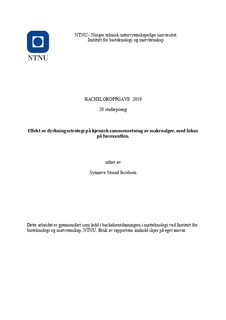| dc.contributor.advisor | Strand, Åse | |
| dc.contributor.author | Jacobsen, Synnøve Strand | |
| dc.date.accessioned | 2019-09-06T14:11:25Z | |
| dc.date.available | 2019-09-06T14:11:25Z | |
| dc.date.issued | 2019 | |
| dc.identifier.uri | http://hdl.handle.net/11250/2613554 | |
| dc.description.abstract | I denne oppgaven har det vært arbeidet med å etablere og tilpasse en metode for ekstraksjon og analyse av karotenoidet fucoxanthin fra brunalgen Saccharina latissima, ved laboratoriene til SINTEF Ocean SeaLab i Trondheim. S. latissima dyrket våren 2018, som en del av prosjektet MACROSEA, ble brukt som prøvemateriale og aceton (62.2 % i MilliQ-vann) ble valgt som løsningsmiddel for å ekstrahere fucoxanthin fra algeprøvene.
Under metodeoptimaliseringsforsøkene ble det testet for tap av ekstraksjonsutbytte ved tre ulike steg i metoden; ekstraksjon, inndamping av løsemiddel med rotavapor og filtrering. To ulike metoder ble brukt for ekstraksjon med aceton, frysetørking av materiale og filtrering før analyse. Den optimaliserte metoden ble så benyttet for å kvantifisere innhold av fucoxanthin i ulike prøver av S. latissima. Mengden ble bestemt med væskekromatografi koblet til massespektrometri (LC-MS/MS). Fucoxanthin-innholdet ble deretter satt i sammenheng med 11 ulike behandlingsmetoder brukt i MACROSEA, for å se på hvordan ulik dyrkningsstrategi kan ha påvirket den kjemiske sammensetningen til algene.
Tap av ekstraksjonsutbytte ved ekstraksjon, inndamping av løsemiddel og filtrering var henholdsvis 7 %, 96 % og 36 %. Ved videre arbeid anbefales det å forbedre samtlige steg. De ulike prøvene hadde generelt små forskjeller i konsentrasjon av fucoxanthin, men det høyeste ekstraksjonsutbyttet ble funnet i prøver med sporer inkubert på laboratorium i 21 dager og vektorpoding i sjø, med fucoxanthin-innhold på hele 1.5 og 1.4 mg per gram tørrvekt tare. Det er uansett vanskelig å si noe om hvilken behandling som anbefales for å oppnå et høyest mulig innhold av fucoxanthin i S. latissima, men ut fra resultatene i denne oppgaven, kan man anta at inkubering i 21 dager av kulturer med sporer er den best egnede dyrkningsstrategien.
Ekstraksjon med aceton (62.2 % i MilliQ-vann) er et godt løsemiddel for å oppnå et høyt ekstraksjonsutbytte av fucoxanthin fra brunalgen S. latissima, men mulighetene for ekstraksjon med enzymer bør undersøkes nærmere for å redusere miljøbelastninger og eksponering for giftstoffer. På grunn av risiko for stort tap i enkelte steg av metoden, bør ytterligere optimalisering være i fokus i videre arbeid. Som forslag til videre arbeid anbefales det å prøve en annen løsemiddelblanding, hvor vann med fordel kan byttes ut med et annet løsemiddel som karotenoider løses godt i, for eksempel metanol. | |
| dc.description.abstract | In this work, a method for extraction and analysis of the carotenoid fucoxanthin from the macro algae Saccharina latissima has been customized and established at the laboratories at SINTEF Ocean SeaLab in Trondheim. Samples of S. latissima cultivated during spring 2018, as a part of the project MACROSEA, were used as test material and acetone (62.2 % in MilliQ-water) was chosen as solvent for extraction.
The possible loss of extraction yield was tested for three different steps during the optimization process; extraction, evaporation of solvent, and filtration. Two different methods were used for extraction, freeze-drying of samples, and filtration before analysis. The optimized method was then used for quantification of fucoxanthin-content in different samples of S. latissima. The amount was decided by Liquid chromatography connected to a mass spectrometry (LC-MS/MS). The content of fucoxanthin was then put in context with 11 different treatments used in MACROSEA, to see how different strategies of cultivation may affect the chemical composition of the algae.
The loss of extraction yield through extraction, evaporation of solvent, and filtration was 7 %, 96 %, and 36 % respectively. In any further work on this method it is recommended to improve all three steps. The differences in the amount of fucoxanthin between the samples were in general low, but the highest extraction yield was achieved in samples with spores incubated for 21 days in the laboratory, and cultivated in sea with vector seeding, with concentrations as high as 1.5 and 1.4 mg per gram dry weight of algea. From the findings in this work it is not possible to decide which cultivation strategy that should be used to achieve the highest possible extraction yield of fucoxanthin from S. latissima, but it might look like the incubation of spores for 21 days is preferable.
Extraction with acetone (62.2 % in MilliQ-water) as solvent is an efficient method to achieve a high extraction yield of fucoxanthin from the macroalgea S. latissima. The possibilities of extraction with enzymes should be further investigated to reduce the environmental impact and exposure of toxic substances. Due to the high risk of possible loss of fucoxanthin during spesific stages in the method, further work should probably focus on additional optimization of the method. A suggestion for any future work on this matter is to try the same method with a different solvent mixture, where water could be replaced with another solvent in which carotenoids dissolve well, for example methanol. | |
| dc.language | nob | |
| dc.publisher | NTNU | |
| dc.title | Effekt av dyrkningsstrategi på kjemisk sammensetning av makroalger, med fokus på fucoxanthin. | |
| dc.type | Bachelor thesis | |
